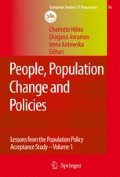Abstract
This article starts with a critical review of Esping-Andersen’s inspiring approach to distinguish between different welfare regimes. The demand firstly to expand the scope of comparative welfare research to all countries participating in the DIALOG project, and to Eastern Europe in general, and secondly the attempt to cope with important shortcomings of Esping-Andersen’s theory, particularly the assumption of strong path dependency, are the main reasons to draft theoretical considerations which focus on a reconciliation of typological approaches on the one hand, and on a functionalist modernisation theory on the other. By referring to (i) Stein Rokkan’s cleavage theory, (ii) Kaufmann’s concept of welfare as a system of dynamic interdependencies and (iii) Cliquet’s generalized Fishbein model (resource-restriction behaviour model); we specify in a first step the relevant sociological dimensions determining the different structures and developments of welfare systems. This leads to the proposal to divide a triad of trajectories (rather than regime types), which are taken as distinct solutions as to how countries can participate in the process of modernisation. Based on a broad set of variables, we try to show in the subsequent sections that the country-specific configuration of cultural and structural macro-conditions, which depend on long-term historical legacies, determine the scope of distinct policies as well as the perception and evaluation of demographic trends. It can be shown that there are strong correlations between the cultural prerequisites and the development of national welfare systems. Furthermore, the hypothesis according to which the Eastern European countries with a Catholic history tend to develop welfare systems in which intermediate institutions (e.g. the family) play an important role (subsidiarity, intergenerational solidarity).By contrast, more secularized Eastern European countries tend to follow rather the trajectory of an encompassing (etatist) social policy. Furthermore, poor economic conditions (particularly in the second belt of transitional countries, (e.g. Moldova, Ukraine, Belarus) currently hamper a rapid improvement of their welfare systems.
Access this chapter
Tax calculation will be finalised at checkout
Purchases are for personal use only
Preview
Unable to display preview. Download preview PDF.
Author information
Authors and Affiliations
Editor information
Editors and Affiliations
Rights and permissions
Copyright information
© 2008 Springer Science + Business Media B.V.
About this chapter
Cite this chapter
Fux, B. (2008). Pathways of Welfare and Population-related Policies. In: Höhn, C., Avramov, D., Kotowska, I.E. (eds) People, Population Change and Policies. European Studies of Population, vol 16/1. Springer, Dordrecht. https://doi.org/10.1007/978-1-4020-6609-2_4
Download citation
DOI: https://doi.org/10.1007/978-1-4020-6609-2_4
Publisher Name: Springer, Dordrecht
Print ISBN: 978-1-4020-6608-5
Online ISBN: 978-1-4020-6609-2
eBook Packages: Humanities, Social Sciences and LawSocial Sciences (R0)

